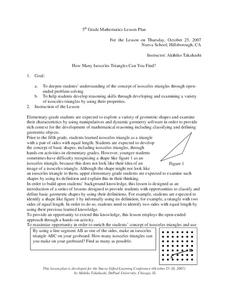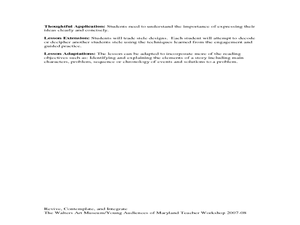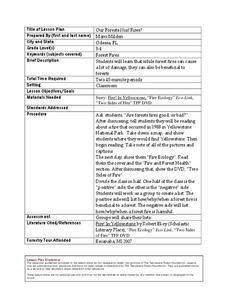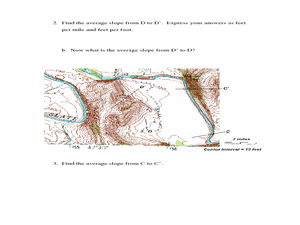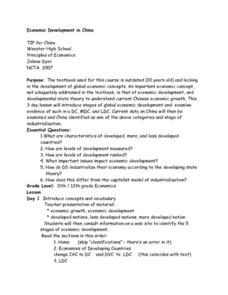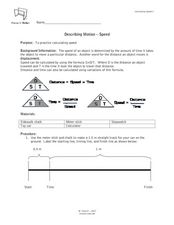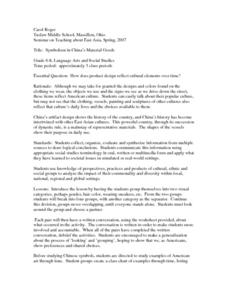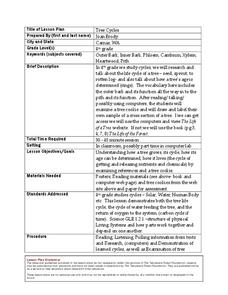Curated OER
Linear Inequalities
Students solve linear inequalities. In this solving linear inequalities lesson plan, students solve one step inequalities algebraically. Students graph the solutions on a number line. Students compare the graphs of various inequalities...
Curated OER
How many isosceles Triangles Can You Find?
Fifth graders solve problems while examining a variety of isosceles triangles. In this isosceles triangle lesson, 5th graders examine shapes to find their characteristics. Students pay particular attention to the characteristics of...
Curated OER
Egyptian Symbols: What story do they tell?
Students create a stele to represent what symbols are the most important to them. In this symbols lesson plan, students learn about Egyptian symbols, and then put their own important symbols into model magic clay according to their size...
Curated OER
The Golden Ratio
Seventh graders investigate a ratio found in nature and in numerous pieces of artwork throughout history. The lesson is cross-curricular and builds a sense of appreciation of design for students.
Curated OER
Pythagorean Theorem
Students discover the Pythagorean Theorem. In this discovering the Pythagorean Theorem lesson, students measure the lengths of various triangles to the nearest centimeter. Students record their measurements in a table. Students square...
Curated OER
Our Forests Need Fires?
Young scholars consider how forest fires are both damaging and beneficial to forests. In this earth science lesson, students are read the book Fire! In Yellowstone by Robert Ekey and watch "Fire Ecology" and "Two Sides of Fire" before...
Curated OER
Slope and Topographic Maps
Students investigate slopes as they study topographic maps. In this algebra lesson, students discuss and apply the concept of slopes to graphing and analyzing data.
Curated OER
Economic Development in China
Students create a poster which depicts and summarizes Rostow's 5 stages of economic development. They make a list of 8 data measures that help identify which level of economic development a country is at. They gather data and...
Curated OER
China - the Geography of European Imperialism - Spheres of Influence in China
Ninth graders create a map of China. They identify the various spheres of influence carved out by the Imperialist powers of Europe as well as locating geographical features of china and major cities. They explain the global impact of...
Curated OER
Reproductive System
Students investigate the medical terms, locations, and purposes of several of the male and female reproductive systems. Feeling good about their bodies and growing up forms the basis of this instructional activity.
Curated OER
Describing Motion-Speed
Students study speed and learn how to calculate it. In this investigative lesson students participate in an activity that shows them how to calculate speed then they fill out a worksheet.
Curated OER
Korean War
Students identify and interpret general information about the Korean War, including important dates, terms, events, and participants. They also identify what the Cairo Declaration was and what military forces, political forces, and...
Curated OER
Bigger Better Bubbles
Students research different types of bubble gum and identify the variables in them. In this bubble gum lesson students design an investigation to test their hypothesis and graph their data.
Curated OER
Communication 5: Defending Your Rights
Students role play situations where they communicate and defend themselves. In this communication lesson plan, students defend their rights by being assertive.
Curated OER
Nottingham
In this language arts activity, students fill in the blanks on 5 sentences. They answer 7 comprehension questions. Students complete a cloze activity of the transcript. The transcript of the article is included, although the main intent...
Curated OER
A Model of a Scanning Tunneling Microscope
Ninth graders explain how a scanning tunneling microscope works. In this chemistry lesson, 9th graders construct atomic models and simulate how their images appear under the STM. They discuss the limitations of their atomic model.
Curated OER
Swimming with Crabs
Students explore Earth science by completing several graphic organizer activities in class. In this oceanography lesson, students research ocean inhabitants such as blue crab and oysters. Students complete graphic organizers about the...
Curated OER
Sequencing Stories
Learners explore dramatization. In this literacy fluency and drama lesson, students listen to the story Mop Top by Don Freeman and add related sounds at the appropriate times. Learners role play, pantomime, and add sounds to create a...
Curated OER
Symbolism in China's Material Goods
Students make a generalization about the process of 'looking' and 'grouping', hoping to show that we, as Americans, show preferences and shared choices. They study examples of American art through time and create a class chart...
Curated OER
Anansi Goes to Lunch
Second graders read the story Anansi Goes to Lunch and complete language arts activities connected to the story. In this language arts lesson plan, 2nd graders complete activities including discussion, reading, writing, drawing, and role...
Curated OER
Tree Cycles
Fourth graders investigate the life cycle of a tree by researching the Internet. In this plant life lesson, 4th graders observe The Life of a Tree website and discuss the life of a tree from sprout to death. Students create a cross...
Curated OER
Forces, Loads, Materials, Shapes
Students investigate forces, loads, materials and shapes as they relate to science. In this science lesson, students differentiate between the basic definitions required to perform a scientific experiment. They answer questions dealing...
Curated OER
Electricity
Young scholars identify the relationship between batteries, circuits and voltage. In this physics lesson, students investigate the way batteries are put into different apparatus. They discuss why different machinery need different...
Curated OER
Electricity
Learners experiment with a series of circuits. In this chemistry lesson, students discuss voltage, resistance and current as they flow through an electrical circuit. They work in pairs to solve the questions.



